Red fox: Two paws, one print

One afternoon in late November I happened to look out my living room window and what should I see but a red fox sniffing around below a bird feeder. While I couldn't tell for sure, it appeared to be hunting the meadow voles or field mice that I often see foraging seeds around the feeder.
While a fairly common sight in the metro river corridor, it turns out that red foxes (Vulpes vulpes) are native to North American boreal and mountainous areas. They didn't appear here in southern Minnesota until after European settlement. Most likely, this stemmed from human-made landscape and habitat changes and the elimination of a chief competitor: the wolf.1 Today, red foxes are one of the most widely distributed carnivores in the world.
Winter's a great time to look for signs of red foxes. Often, they travel in what's called a direct register trot, where the rear foot lands directly on top of the spot that the front foot just left. This results in a straight line of tracks similar to a cat's. One print in the snow represents the impression of two paws. Follow this trail of tracks and you'll undoubtedly come upon a strong musky urine scent that marks a prominent structure such as a stump or large rock. Such scent marking is an important means of communication for this species.2
For additional fascinating fox facts, I highly recommend this Mental Floss article. If you'd prefer something more on the scholarly side, check out the articles referenced above: The origin of recently established red fox populations in the United States: translocations or natural range expansions? from the Journal of Mammology or Ontogenic patterns of scent marking in red foxes from Folia Zoologica.